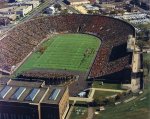Keep in mind, that there are many other goals and objectives the U had beyond a simple attendance number. Among them:
- Rein in suite, concession, and parking revenue that were lost due to sharing a stadium. Even better negotiating would likely still have resulted in less than they're getting today
- Build a collegiate experience that connects with those that do show up to games. Branding, logos, music, the feel of the venue, etc all play in to this
- Help with recruiting. Yes, the same was said for the Dome; using an NFL caliber venue to lure HS kids was seen as a panacea to an aging Memorial facility. This tactic has proven not to work at pretty much every college sharing a venue (Syracuse, Pitt, NIU, Miami, etc, with the latter bringing in talent with money and the promise of babes/weather/beaches)
- Ancillary university benefits such as providing a home for the UMN Marching band (freeing up Northrop and the parking lot for other, more productive uses (both athletic and academic)), adding space on campus for career fairs and other academic meetings
- Additional revenue potential by hosting weddings, concerts, and other events in the stadium
- Use this revenue to cut down the amount of subsidy from the university to athletics and/or add more sports long term and/or build other athletic training facilities
Yes, it would be great if the venue itself could simply pull in crowds of people more than the Dome did, and for all we know (given recession, poor team performance, etc), it actually DID pull in more people than the Dome would during the same timeframe. But I think even the biggest TCF fanboy knew that after 1-2 years, most casual fans would have visited TCF for the novelty and it would come back to W/L and general atmosphere to bring fans in.
As for these 2 articles... excellent reporting, don't bother evaluating data/information any further than surface-level!



